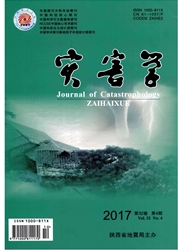

 中文摘要:
中文摘要:
利用1961~2014年(10月至次年4月)宁夏20个气象站气候资料,分析宁夏冬季采暖期的时空变化特征,以及采暖期内气候资源的变化特征及其对采暖强度的影响。结果表明:(1)宁夏由南到北采暖初日推迟,终日提前,采暖强度减弱;(2)与实际供暖初、终日期相比,北部引黄灌区采暖初日偏晚,终日偏早,采暖长度短于供暖长度;中部干旱带两者基本接近;南部山区采暖初日偏早,终日偏晚,采暖长度长于供暖长度;(3)随着气候变暖,近53 a宁夏采暖初日推后,终日提前,终日提前趋势较初日推后趋势更明显,采暖期长度缩短,北部引黄灌区缩短最多;整体上,采暖强度显著减弱,但2002年以后中北部地区气温降低,导致日平均采暖强度及采暖强度有增加趋势;(4)夜间升温对采暖强度减小的贡献大于白天升温的贡献;(5)近53 a日照时数和降水量变化对中南部地区采暖强度的影响大于北部引黄灌区;(6)气候变暖对减少冬季采暖能耗的贡献为12.8%~16.5%,但中北部地区2002年以后对减少采暖能耗的贡献有所降低。
 英文摘要:
英文摘要:
Based on the daily meteorological observation data of 20 weather stations in Ningxia during 1961 -2014 (from October to the next April),the temporal amd spatial distribution characteristics of heating peroid in winter were studied,and the variations of climatic resources and their effect on the heating intensity were analyzed.The results are as follows:(1 )The beginning date of winter heating put off and the ending date was ahead from south to north area in Ningxia during 1961 -2013,and the heating intensity weakened. (2)Compared with the actual date of heating,the beginning date was later and the ending date was earlier in the Yellow River irriga-tion area of Ningxia,therefore the heating days was shorter,while they were opposite in southern mountain area.(3 )With climate warming,the beginning date of winter heating appearred a delaying trend and the ending date showed an advancing trend in the past 53 years in Ningxia,and the change trend of the latter was obvious than the former,then the heating days shortened,especially in the Yellow River irrigation area.The heating intensity in Ningxia weakened markedly during 1961 -2013,but the temperature in the mid-dle and north of Ningxia decreased since 2002,which led to increase of the heating intensity in every day and during the winter heating peroid.(4)The contribution of the temperature rising at night to heating intensity was greater than that in the daytime.(5)The influ-ences of sunshine hours and precipitation on heating intensity in middle arid area and southern mountain area of Ningxia were greater than that in the Yellow River irrigation area.(6)The contribution of climate warming to reducing the energy consumption of heating in winter was 12.8%-16.5%,but that in the middle and north of Ningxia decreased since 2002.
 同期刊论文项目
同期刊论文项目
 同项目期刊论文
同项目期刊论文
 期刊信息
期刊信息
